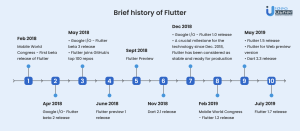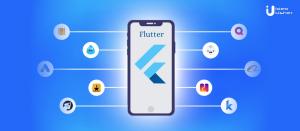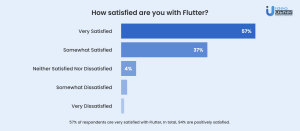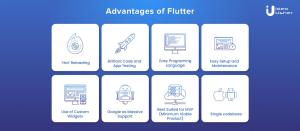The last few years have seen a sudden rise in mobile and web applications. The current number of smartphone users in the world today has touched almost 3.8 billion. This means 48.20% of the world’s population now owns a smartphone.
With technology on the rise, people prefer to operate mainly from their smartphone screens. Start-up owners have taken to mobile applications to connect with existing and potential clients. Needless to say, this has resulted in an unprecedented growth in the app market, with the number likely to only increase in the upcoming years.
Like a domino effect, the rise in mobile applications means there is a sudden jump in app developers and app development companies. These organizations are trying their best to make the app development process simpler and much faster.
Before moving any further, you must know that there are two types of platforms to develop mobile applications for-
iOS– the apps made for Apple devices. These types of apps are made using the Swift language with an extension of .ipa
Android– apps made for Android devices. These android apps are made using Java and Kotlin. They have an extension of .apk
But both these two platforms exist side by side. THey command their own loyal community of users which means app developers have to develop apps for both Android and iOS simultaneously.
Now, this is a lengthy and difficult process and is not cost-effective, to say the least.
Some of the biggest challenges that cross-platform developers encountered were-
- Time Constraint
- Steep development cost
- More number of employees
- No cross-platform dependency
This is where Flutter appeared as a boon.

Also, read Native Vs Hybrid Mobile App Development – What’s Best For Your Business?
In this blog, the expert at Idea Usher explains to you the 7 ways Flutter is setting the trend in mobile app development.
What is Flutter?
Flutter was launched in 2007 by Google as an answer to all the ongoing problems in the app development industry. It is a powerful language that is packed with a robust mobile framework. This means it can be used in both iOS and Android applications.
It is Google’s UI toolkit to build beautiful, natively compiled applications for mobile, web, desktop, and embedded devices all from a single codebase. It provides a simple, efficient, powerful, and easy-to-understand SDK to write mobile applications in Google’s own language, Dart.

Apart from the obvious advantage of being able to create cross-platform apps, Flutter also came built with its own material design and graphics library. This allows faster development of apps, rendering stunning visuals, no matter which platform it is being used on.
| Brief Overview about Flutter | |
| Launch Date | May 2017 |
| Creator | |
| Programming Language | Dart |
| Operating platform | Android, iOS, Linux, Mac, Windows, Google Fuchsia |
| Framework Architecture | Dart platform
Flutter engine Foundation library Design-specific widgets Flutter Development Tools (DevTools)
|
How does Flutter work?
Before shifting to how Flutter is setting the trend in mobile app development, let us take a look at how Flutter works to deliver a simple, high-performance application network.
1. Platform
Flutter uses the platform Shell, which is the host of the Dart VM. The Shell has a number of functions. It provides communication to the relevant IMEs. It also gives access to native APIs. Shell also hosts a platform-relevant canvas.
2. Engine
The Engine runs inside the platform Shell. The engine provides Skia, Platform Channels, Dart Runtime, among many other things.
3. Framework
This is undoubtedly the most important feature of Flutter. This allows apps developed on Flutter to resemble native Android and iOS apps through the use of the right themes.
Widgets are UI controls that can be likened to the building blocks of apps. The widgets used are Cupertino and Material for iOS and Android respectively. In Flutter, there are both Stateless and Stateful widgets.
The framework of Flutter has been designed in a way that app developers are provided with a core UI model. This helps generate widgets as and when required. Flutter, which has inbuilt advanced animation, painting, and gesture support, will render it for you. This allows you to create widgets and make them behave as per your wish.
4. Rendering Pipeline
Flutter UI uses Skia Canvas for building and rendering UI. It implements GPU and updates UI at 60 fps, which is the secret behind its smooth UI.
General trivia about Flutter

- Since its launch in 2017, Flutter has cemented its place in the list of powerful frameworks for app development.
- Flutter was released to compete with Facebook’s React Native, with the promise of a hybrid application development that requires lesser resources, including time and cost.
Also, read Flutter Vs. React Native
- Since Flutter released its version 1.0 in December 2018, nearly 2 million developers have used Flutter. Google has recently revealed that an astounding half a million developers now use Flutter each month. There are about 50,000 Flutter apps on Google Play, nearly 10,000 of which were uploaded in the past month only.

- In its recently published report, Google broke down the share of Flutter developers: 35% work for start-ups, 26% are enterprise developers, 19% are self-employed, and 7% work for design agencies.
- 60% of these users are developing with Windows, 27% are using macOS and 13% are using Linux.
- 78% of Flutter developers use the stable channel, 11% use beta, and 11% use either dev or master.
- The top five territories for Flutter are India, China, the United States, the EU, and Brazil.
- Polls on StackOverflow statistics show that Flutter has a score of 68.8% in the category of most loved technology.
- According to The statistics, Flutter has 13K contributors to open-source projects.
- Flutter has accumulated 114k stars on GitHub, not an easy feat for a newly developed platform
- Google launched Flutter app development services 1.12 in 2019, leaving developers excited.
The tremendous popularity of Flutter within such a short period can largely be credited to the speedy development process and reduced development cross. But there are other features that have contributed to the development of a holistic development system. Here, in this blog, we have decided to highlight a few of them.
Ways in which Flutter is setting the trend in mobile app development

1. Single codebase
The most distinctive characteristic of Flutter most distinctive is the write-once principle. Due to this, developers no longer have to adapt manually to multiple platforms. This was a problem they faced with traditional cross-platform approaches.
The Flutter app development platform means only one-time coding for both platforms, Android and IOS, and not a second time for both. This makes Flutter a wise choice, according to most developers. Flutter cuts down on both user and developer efforts with its Hybrid App Development framework. This results in improved quality, design, and speed of the application.
2. Brilliant Code and app testing
Before Flutter, developers had to write a different codebase for two separate applications (iOS & Android). A single application developed with a single code-based will take less time to write, test, and be deemed qualified as an ideal app.
However, Flutter app development eases the method further and accelerates the event process. The single codebase approach allows developers to reuse it with different plugins, which results in lesser development time. During testing, a simple QA is enough to verify the functionality, features, and program of any cross-platform mobile app.
3. ‘Hot’ reloading
‘Hot’ reloading accelerates the re-development cycle by allowing changes to a live running application. This enables the app to pick up from where it left off without restarting whenever anything changes in the app. This feature makes all design changes visible, speeding up the method of fixing bugs, UI building, and adding more features to the Flutter apps in real time.
4. Best suited for MVP
If you are unsure about using Flutter, here is a viable argument. The speed with which you can produce your MVP (Minimum Viable Product) on Flutter for any app is unmatched. To create an MVP in Flutter, you simply have to invest a little amount of your time and energy. Although that comes with its own shortcoming- Flutter’s MVP development is somewhat limited.
Flutter SDK comes with less coding because nearly all codes are swapped between iOS and Android apps. As a result, the cost of Flutter app development services for a startup, particularly for MVPs, is dramatically lowered.
4. Use of custom widgets
Engineers may simply follow Material Design or Cupertino design requirements with Flutter’s vast choice of platform-specific widgets. Furthermore, any widget can be easily changed in terms of color, shape, element transitions, shadow manipulations, clipping, and other modifications.
5. Easy programing language
Flutter is predicated on Google’s in-house programming language — Dart. Hence there’s no need for communication with native modules. It is characterized by simplicity and accessibility. Dart was introduced in 2011 but has only risen in popularity since Google made its announcement of Flutter. It is evolving rapidly and is consistent with GitHub, the fastest-growing language in 2019.
Dart is a simple language to find out and shares many traits with other popular languages like Swift and Kotlin. If you’re already conversant in other languages, you’ll likely become productive with Dart in a matter of weeks.
Also read: Kotlin vs Java: The Ultimate Battle
6. Easy setup and maintenance
In Flutter, it is relatively easy to develop and maintain the app due to a single codebase. Easy setup and maintenance of Flutter result in improved performance of the application as compared to other app development platforms. This in turn helps lower maintenance efforts. Hence, if the app owner or developer does not want to spend extra money on powerful machines then, the Flutter app is the best option for you.
7. Google has massive support
As we know by now, Flutter is developed by the tech giant – Google. This is the reason why Google consistently supports Flutter developers with frequent updates and issue fixes. Apart from Google’s assistance, there are ready-made SDKs for numerous Google products, such as Firebase.
Why Flutter mobile application development is the best choice for startups?

Google, in its 2020 Q2 survey, stated that “Flutter usage is growing fast among enterprise customers in particular.”
Large companies specifically appreciate the ability of Flutter to build highly branded experiences that support multiple platforms. Google built Flutter so that when developers start creating apps, their primary question should not be “Which device am I targeting?” but “What am I going to build?”
Start-ups are often limited by resources and burdened by budget constrictions. The single codebase allows developers to reuse the code. This can lower the need for manpower and capital to a large extent. This will further let enterprises consolidate teams into shipping a single experience.
Some of the most renowned start-ups and tech giants, such as Tencent and Alibaba, have already integrated Flutter to develop their business mobile applications. Within a short period, Flutter has shown considerable growth, even more than other cross-platform application development frameworks such as Xamarin, Angular, and React Native. Flutter has a bright future for cross-platform mobile application development, especially when it is being used by Google for UI rendering in Fuchsia OS.
At the end of the day, compared to native apps, which are required to be developed individually for every platform, start-ups need an app that can work on different platforms at one go. This is where Flutter comes into the picture.
Advantages of Flutter
- Powerful design- Flutter comes built with the latest framework, which means it requires very little time and effort to design some of the most powerful apps.
- Cross-platform operations– There is no need to redesign and reconfigure apps developed on Flutter to suit different platforms. They operate smoothly on both platforms (iOS and Android)
- Time constraint- There is one major advantage of building a hybrid app. It works independently, irrespective of the platform. The time required to develop and launch such apps is considerably less. In the case of Flutter, everything being predesigned means the risk of bugs is eliminated.
- Less number of developers- Flutter apps requiring a single codebase means there is a lesser number of developers required. This no doubt decreases the development cost.
- Less development cost- The small team of developers required means it has a direct effect on the development cost. The single codebase also contributes to the lowered cost.
- Firebase as backend- Firebase offers a complete package to the developers. From cloud storage to real-time database, hosting to authentication services. This makes for a seamless experience on the part of the Flutter app developers, no doubt contributing to its popularity.
A Skilled Developer For Every Project Trusted by 100+ clients
Disadvantages of Flutter
- App Performance– Flutter is armed with the latest technologies. This signifies apps made on Flutter will work a bit slower on older devices. The older devices have been designed to work only with native codes.
- Different working- Apps developed on Flutter are hybrid apps. This inadvertently means they work and feel different from those developed specifically for native platforms. Although the design is different, the required operation of such apps remains the same.
Final Words
Hybrid apps are being considered the next generation of applications because they provide platform independence and access to the inbuilt device features at the same time.
Moreover, they efficiently function offline and can be uploaded to the app stores like the native ones. More and more companies are looking to Flutter for a free, reliable, easy-to-use platform with the added benefit of code reusability, cost-effective cross-platform development, and design-specific UI elements. With Google promising more updates, we are about to see Flutter rule the space of app development in the near future.
Idea Usher has, over the years, built hundreds of apps, collaborating with over 1000+ clients across 50 countries. Our developers have thousands of hours of experience developing apps across various platforms, including Flutter. To know more, you can approach our company and get expert consultation for free.
Build Better Solutions With Idea Usher
Professionals
Projects
FAQ
Q. What is the cost of app development on Flutter?
Google offers Flutter completely free of cost. With the right coding knowledge, you can build any cross-platform mobile app without any development charge on Flutter.
Q. Is it necessary to hire professional Flutter developers?
If you are confident about your programming knowledge, you can develop apps on the Flutter platform on your own. But if you are looking to further customize your app and integrate 3rd party toll APIs, then you should definitely go for a team of professionals for the best UI/UX along with fast development and support.
Q. What programming language is used in Flutter?
Dart, Google’s own data programming language, is used by Flutter. It is one of the most powerful programming languages currently in existence.



















